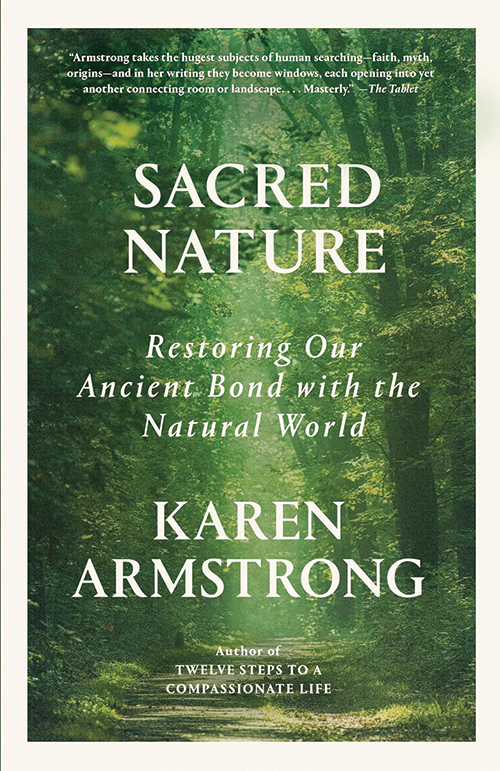
Sacred Nature: Restoring Our Ancient Bond with the Natural World
Reviewed by Ruah Swennerfelt
November 1, 2023
By Karen Armstrong. Alfred A. Knopf, 2022. 224 pages. $28/hardcover; $17/paperback; $12.99/eBook.
Through my reading of Indigenous writers, such as Robin Wall Kimmerer; or my reading of Starhawk’s knowledge of earth-based spirituality, derived from early Europeans; or my learning from Friend Jim Kessler who knows love of the land from personal experience and his deeply held Christian beliefs, I’ve come to understand how separation from the natural world leads to seeing nature as a commodity instead of knowing all life as family. And this understanding has led me to seek a life, connect to place, and act on behalf of the earth. There’s a common phrase about the human and other-than-human relationship that is shared by many Indigenous peoples: “all our relations.” This speaks to me. It is possible to be outside and feel this deep relationship with the trees; birds; plants; water; insects; and, well, everything.
In Sacred Nature, Karen Armstrong unveils these same ideas through her understanding of the major religious traditions. She is best known as a religious historian, and this book was written because of her concern about the human factor in climate change and her concern about the human relationship with nature.
I don’t have much knowledge of Eastern religions, so it was fascinating to read the earth-linked thinking of Confucianism, Daoism, and Jainism. The author explores the sacred texts of the major religions, revealing where they have supported this relationship and seen nature as sacred, and hoping that through understanding these insights, readers will be inspired to change from separation to connection. Although Armstrong often uses the word we, which doesn’t acknowledge that not all people are living lives of separation, I’ve chosen two quotes for this review that are still inspiring and directly share her thoughts. She writes:
We must re-form our attitude to nature and that will entail sacrifice. We can no longer board aeroplanes, drive our cars, or burn coal with our former insouciance. . . . We cannot save our planet unless we undergo a radical change of mind and heart, which will inevitably be demanding.
Armstrong also shares inspiring words from William Wordsworth and Samuel Taylor Coleridge, and she explores the meaning of the story of Job. At the end of each chapter, she adds a section called “The Way Forward,” sharing how the reader can learn from what is read and then transform that understanding into action.
And of interest to Quakers, she emphasizes the importance of silence and solitude. According to Armstrong, “If we develop a mind that ‘watches and receives’ and discover the fluidity of our natural environment, we may be able to recover some of our ancestors’ vision of a sacred nature.” She hopes that with this new vision and understanding humans will stop contributing to, or start helping to end, our destruction of life on this planet Earth.
Ruah Swennerfelt is a member of Middlebury (Vt.) Meeting and serves on its Earthcare Committee. She formerly was general secretary of Quaker Earthcare Witness. She and her husband homestead on the unceded land of the Abenaki, in a solar-powered home. She also serves on the board of Sustainable Charlotte Vermont.



Comments on Friendsjournal.org may be used in the Forum of the print magazine and may be edited for length and clarity.